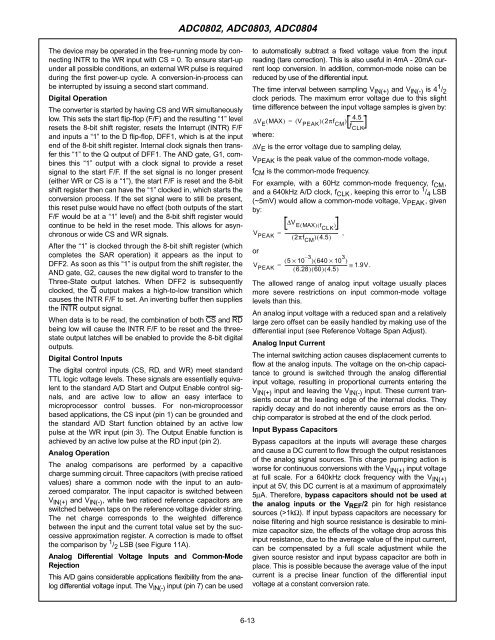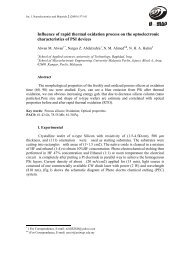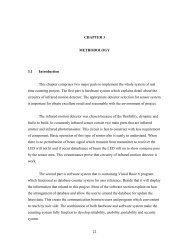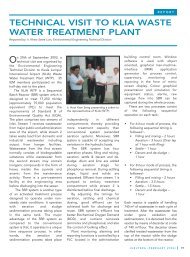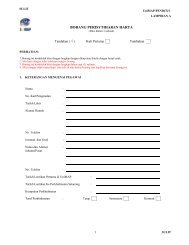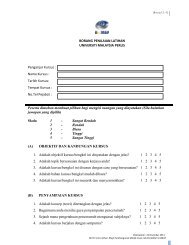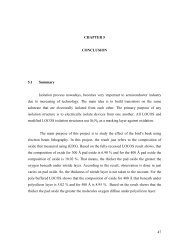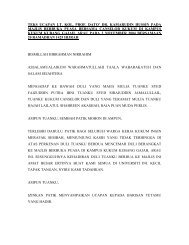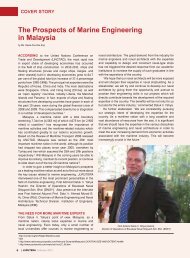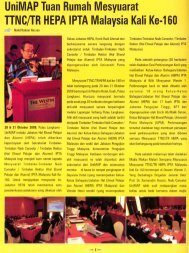CHAPTER 3 METHODOLOGY 3.1 Overview The Water Monitoring ...
CHAPTER 3 METHODOLOGY 3.1 Overview The Water Monitoring ...
CHAPTER 3 METHODOLOGY 3.1 Overview The Water Monitoring ...
Create successful ePaper yourself
Turn your PDF publications into a flip-book with our unique Google optimized e-Paper software.
ADC0802, ADC0803, ADC0804<strong>The</strong> device may be operated in the free-running mode by connectingINTR to the WR input with CS = 0. To ensure start-upunder all possible conditions, an external WR pulse is requiredduring the first power-up cycle. A conversion-in-process canbe interrupted by issuing a second start command.Digital Operation<strong>The</strong> converter is started by having CS and WR simultaneouslylow. This sets the start flip-flop (F/F) and the resulting “1” levelresets the 8-bit shift register, resets the Interrupt (INTR) F/Fand inputs a “1” to the D flip-flop, DFF1, which is at the inputend of the 8-bit shift register. Internal clock signals then transferthis “1” to the Q output of DFF1. <strong>The</strong> AND gate, G1, combinesthis “1” output with a clock signal to provide a resetsignal to the start F/F. If the set signal is no longer present(either WR or CS is a “1”), the start F/F is reset and the 8-bitshift register then can have the “1” clocked in, which starts theconversion process. If the set signal were to still be present,this reset pulse would have no effect (both outputs of the startF/F would be at a “1” level) and the 8-bit shift register wouldcontinue to be held in the reset mode. This allows for asynchronousor wide CS and WR signals.After the “1” is clocked through the 8-bit shift register (whichcompletes the SAR operation) it appears as the input toDFF2. As soon as this “1” is output from the shift register, theAND gate, G2, causes the new digital word to transfer to theThree-State output latches. When DFF2 is subsequentlyclocked, the Q output makes a high-to-low transition whichcauses the INTR F/F to set. An inverting buffer then suppliesthe INTR output signal.When data is to be read, the combination of both CS and RDbeing low will cause the INTR F/F to be reset and the threestateoutput latches will be enabled to provide the 8-bit digitaloutputs.Digital Control Inputs<strong>The</strong> digital control inputs (CS, RD, and WR) meet standardTTL logic voltage levels. <strong>The</strong>se signals are essentially equivalentto the standard A/D Start and Output Enable control signals,and are active low to allow an easy interface tomicroprocessor control busses. For non-microprocessorbased applications, the CS input (pin 1) can be grounded andthe standard A/D Start function obtained by an active lowpulse at the WR input (pin 3). <strong>The</strong> Output Enable function isachieved by an active low pulse at the RD input (pin 2).Analog Operation<strong>The</strong> analog comparisons are performed by a capacitivecharge summing circuit. Three capacitors (with precise ratioedvalues) share a common node with the input to an autozeroedcomparator. <strong>The</strong> input capacitor is switched betweenV lN(+) and V lN(-) , while two ratioed reference capacitors areswitched between taps on the reference voltage divider string.<strong>The</strong> net charge corresponds to the weighted differencebetween the input and the current total value set by the successiveapproximation register. A correction is made to offsetthe comparison by 1 / 2 LSB (see Figure 11A).Analog Differential Voltage Inputs and Common-ModeRejectionThis A/D gains considerable applications flexibility from the analogdifferential voltage input. <strong>The</strong> V lN(-) input (pin 7) can be usedto automatically subtract a fixed voltage value from the inputreading (tare correction). This is also useful in 4mA - 20mA currentloop conversion. In addition, common-mode noise can bereduced by use of the differential input.<strong>The</strong> time interval between sampling V IN(+) and V lN(-) is 4 1 / 2clock periods. <strong>The</strong> maximum error voltage due to this slighttime difference between the input voltage samples is given by:4.5∆V E( MAX)= ( V PEAK)( 2πf CM) ------------f CLKwhere:∆V E is the error voltage due to sampling delay,V PEAK is the peak value of the common-mode voltage,f CM is the common-mode frequency.For example, with a 60Hz common-mode frequency, f CM ,and a 640kHz A/D clock, f CLK , keeping this error to 1 / 4 LSB(~5mV) would allow a common-mode voltage, V PEAK , givenby:∆V E( MAX)( fCLK )V PEAK= ------------------------------------------------- ,( 2πf CM )( 4.5)or( 5 × 10 – 3 )( 640 × 10 3 )V PEAK = --------------------------------------------------------- ≅ .( 6.28) ( 60) ( 4.5)1.9V<strong>The</strong> allowed range of analog input voltage usually placesmore severe restrictions on input common-mode voltagelevels than this.An analog input voltage with a reduced span and a relativelylarge zero offset can be easily handled by making use of thedifferential input (see Reference Voltage Span Adjust).Analog Input Current<strong>The</strong> internal switching action causes displacement currents toflow at the analog inputs. <strong>The</strong> voltage on the on-chip capacitanceto ground is switched through the analog differentialinput voltage, resulting in proportional currents entering theV IN(+) input and leaving the V IN(-) input. <strong>The</strong>se current transientsoccur at the leading edge of the internal clocks. <strong>The</strong>yrapidly decay and do not inherently cause errors as the onchipcomparator is strobed at the end of the clock perIod.Input Bypass CapacitorsBypass capacitors at the inputs will average these chargesand cause a DC current to flow through the output resistancesof the analog signal sources. This charge pumping action isworse for continuous conversions with the V IN(+) input voltageat full scale. For a 640kHz clock frequency with the V IN(+)input at 5V, this DC current is at a maximum of approximately5µA. <strong>The</strong>refore, bypass capacitors should not be used atthe analog inputs or the V REF /2 pin for high resistancesources (>1kΩ). If input bypass capacitors are necessary fornoise filtering and high source resistance is desirable to minimizecapacitor size, the effects of the voltage drop across thisinput resistance, due to the average value of the input current,can be compensated by a full scale adjustment while thegiven source resistor and input bypass capacitor are both inplace. This is possible because the average value of the inputcurrent is a precise linear function of the differential inputvoltage at a constant conversion rate.6-13


